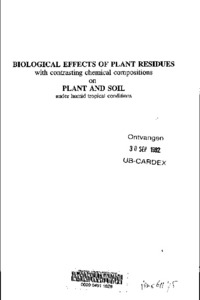| dc.contributor.author | Tian, G. |
| dc.contributor.author | Kang, B. |
| dc.contributor.author | Brussaard, Lijbert |
| dc.date.accessioned | 2019-12-04T11:27:41Z |
| dc.date.available | 2019-12-04T11:27:41Z |
| dc.date.issued | 1992 |
| dc.identifier.citation | Tian, G., Kang, B. & Brussaard, L. (1992). Biological effects of plant residues with contrasting chemical composition under humid tropical conditions - decomposition and nutrient release. In G. Tian, Biological effects of plant residues with contrasting chemical compositions on plant and soil under humid tropical conditions, New York,USA: Kluwer Academic Publisher, (p. 29-50). |
| dc.identifier.issn | 0038-0717 |
| dc.identifier.uri | https://hdl.handle.net/20.500.12478/4989 |
| dc.description.abstract | Decomposition and nutrient release patterns of prunings of three woody agroforestry plant species (Acioa barteri, Gliricidia sepium and Leucaena leucocephala), maize (Zea mays) stover and rice (Oryza sativa) straw, were investigated under field conditions in the humid tropics, using litterbags of three mesh sizes (0.5, 2 and 7 mm) which allowed differential access of soil fauna. The decomposition rate constants ranged from 0.01 to 0.26 week−1, decreasing in the following order; Gliricidia prunings >Leucaena prunings > rice straw > maize stover >Acioa prunings. Negative correlations were observed between decomposition rate constants and C:N ratio (P < 0.004), percent lignin (P < 0.014) and polyphenol content (P < 0.053) of plant residues. A positive correlation was observed between decomposition rate constant and mesh-size of litterbag (P < 0.057). These results indicate that both the chemical composition of plant residues and nature of the decomposer played an important role in plant residue decomposition. Nutrient release differed with quality of plant residues and litterbag mesh-size. Total N, P, Ca and Mg contents of plant residues decreased with time for Gliricidia and Leucaena prunings, maize stover, and rice straw, and increased with time for Acioa prunings. There was some indication of N immobilization in maize stover and rice straw; P immobilization in Leucaena prunings and rice straw; and Ca immobilization in maize stover, rice straw and Gliricidia and Leucaena prunings. Acioa prunings immobilized N, P, Ca and Mg. All plant residues released K rapidly. Nutrient release increased with increasing mesh-size of litterbags, suggesting that soil faunal activities enhanced nutrient mobilization. |
| dc.language.iso | en |
| dc.subject | Decomposition |
| dc.subject | Nutrients |
| dc.subject | Soil Fauna |
| dc.title | Biological effects of plant residues with contrasting chemical composition under humid tropical conditions decomposition and nutrient release |
| dc.type | Book Chapter |
| dc.description.version | Peer Review |
| cg.contributor.affiliation | International Institute of Tropical Agriculture |
| cg.contributor.affiliation | Wageningen University and Research Centre |
| cg.coverage.region | Africa |
| cg.coverage.region | Acp |
| cg.coverage.region | West Africa |
| cg.coverage.region | Europe |
| cg.coverage.country | Nigeria |
| cg.coverage.country | Netherlands |
| cg.isijournal | ISI Journal |
| cg.authorship.types | CGIAR and advanced research institute |
| cg.iitasubject | Integrated Soil Fertility Management |
| cg.iitasubject | Soil Fertility |
| cg.iitasubject | Soil Information |
| cg.iitasubject | Nutrition |
| cg.accessibilitystatus | Open Access |
| local.dspaceid | 102252 |

